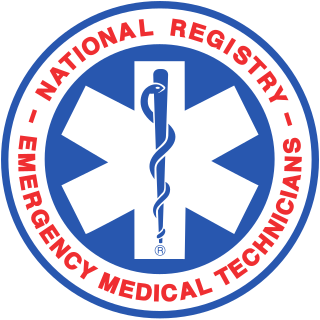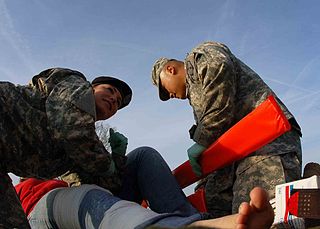
The Federal Emergency Management Agency (FEMA) is an agency of the United States Department of Homeland Security (DHS), initially created under President Jimmy Carter by Presidential Reorganization Plan No. 3 of 1978 and implemented by two Executive Orders on April 1, 1979. The agency's primary purpose is to coordinate the response to a disaster that has occurred in the United States and that overwhelms the resources of local and state authorities. The governor of the state in which the disaster occurs must declare a state of emergency and formally request from the President that FEMA and the federal government respond to the disaster. The only exception to the state's gubernatorial declaration requirement occurs when an emergency or disaster takes place on federal property or to a federal asset—for example, the 1995 bombing of the Alfred P. Murrah Federal Building in Oklahoma City, Oklahoma, or the Space Shuttle Columbia in the 2003 return-flight disaster.

An emergency medical technician is a medical professional that provides emergency medical services. EMTs are most commonly found serving on ambulances and in fire departments in the US and Canada, as full-time and some part-time departments require their firefighters to be EMT certified.

A paramedic is a healthcare professional trained in the medical model, whose main role has historically been to respond to emergency calls for medical help outside of a hospital. Paramedics work as part of the emergency medical services (EMS), most often in ambulances. They also have roles in emergency medicine, primary care, transfer medicine and remote/offshore medicine. The scope of practice of a paramedic varies between countries, but generally includes autonomous decision making around the emergency care of patients.

In the United States, state defense forces (SDFs) are military units that operate under the sole authority of a state government. State defense forces are authorized by state and federal law and are under the command of the governor of each state.

A certified first responder is a person who has completed a course and received certification in providing pre-hospital care for medical emergencies. Certified individuals should have received much more instruction than someone who is trained in basic first aid and cardiopulmonary resuscitation (CPR) but they are not necessarily a substitute for more advanced emergency medical care rendered by emergency medical technicians and paramedics. First responders typically provide advanced first aid level care, CPR, and automated external defibrillator (AED) usage. The term "certified first responder" is not to be confused with "first responder", which is a generic term referring to the first medically trained responder to arrive on scene and medically trained telecommunication operators who provide pre-arrival medical instructions as trained Emergency Medical Dispatchers (EMD). Many police officers and firefighters are required to receive training as certified first responders. Advanced medical care is typically provided by EMS, although some police officers and firefighters also train to become emergency medical technicians or paramedics.

A medic is a medical practitioner or student such as a medical doctor or an emergency medical responder such as a paramedic.

The Star of Life is a symbol used to identify emergency medical services. It features a blue six-pointed star, outlined by a white border. The middle contains a Rod of Asclepius – an ancient symbol of medicine. The Star of Life can be found on ambulances, medical personnel uniforms, and other objects associated with emergency medicine or first aid. Elevators marked with the symbol indicate the lift is large enough to hold a stretcher. Medical bracelets sometimes use the symbol to indicate one has a medical condition that emergency services should be aware of.

Uniformed Services University of the Health Sciences (USU) is a health science university of the U.S. federal government. The primary mission of the school is to prepare graduates for service to the U.S. at home and abroad as uniformed health professionals, scientists and leaders; by conducting cutting-edge, military-relevant research; by leading the Military Health System in key functional and intellectual areas; and by providing operational support to units around the world.
Allied health professions are health care professions that provide a range of diagnostic, technical, therapeutic, and support services in connection with health care. Their services are allied with and support the work of a number of other professions not considered allied health professions, such as medicine, nursing, dentistry, optometry, pharmacy, and others listed below as "excluded professions".

The Public Health Service Act is a United States federal law enacted in 1944. The full act is codified in Title 42 of the United States Code, Chapter 6A . This Act provided a legislative basis for the provision of public health services in the United States.

In the United States, the paramedic is a allied health professional whose primary focus is to provide advanced emergency medical care for patients who access Emergency Medical Services (EMS). This individual possesses the complex knowledge and skills necessary to provide patient care and transportation. Paramedics function as part of a comprehensive EMS response under physician medical direction. Paramedics often serve in a prehospital role, responding to Public safety answering point (9-1-1) calls in an ambulance. The paramedic serves as the initial entry point into the health care system. A standard requirement for state licensure involves successful completion of a nationally accredited Paramedic program at the certificate or associate degree level.

Emergency medical services in the United Kingdom provide emergency care to people with acute illness or injury and are predominantly provided free at the point of use by the four National Health Services (NHS) of England, Scotland, Wales, and Northern Ireland. Emergency care including ambulance and emergency department treatment is only free to UK residents and a charge may be made to those not entitled to free NHS care.

Emergency medical personnel in the United Kingdom are people engaged in the provision of emergency medical services. This includes paramedics, emergency medical technicians and emergency care assistants. 'Paramedic' is a protected title, strictly regulated by the Health and Care Professions Council, although there is tendency for the public to use this term when referring to any member of ambulance staff.

The National Registry of Emergency Medical Technicians is a US certification agency covering prehospital medical providers.
Emergency Medical Technician is the entry level of Emergency Medical Technician in the United States.

Glenn William "GT" Thompson Jr. is an American politician serving as the U.S. representative for Pennsylvania's 15th congressional district since 2019. A member of the Republican Party, he was first elected to Congress in 2008 for the state's 5th congressional district; Thompson was redistricted to the 15th congressional district in the 2018 election by an order of the Supreme Court of Pennsylvania. Since 2023, he has chaired the House Agriculture Committee.

Emergency medical responders are people who are specially trained to provide out-of-hospital care in medical emergencies. There are many different types of emergency medical responders, each with different levels of training, ranging from first aid and basic life support. Emergency medical have clinical experience or clinical skills of emergency medical services (EMS) personnel. The EMR program is not intended to replace the roles of emergency medical technicians or paramedics and their wide range of specialties. Emergency medical responders typically assist providing basic life support. "Emergency medical responder" is a broad term, used either to describe a certain EMS certification level, or generally to describe those who respond to medical emergencies. Specifically used, an Emergency Medical Responder is an EMS certification level used to describe a level of EMS provider below that of an emergency medical technician and paramedic. Broadly used, a first responder is the first medically trained personnel who comes in contact with a patient. This could be a passerby, citizen volunteer, or fire department, police, or emergency medical services personnel.

The Biomedical Advanced Research and Development Authority (BARDA)' is a U.S. Department of Health and Human Services (HHS) office responsible for the procurement and development of medical countermeasures, principally against bioterrorism, including chemical, biological, radiological and nuclear (CBRN) threats, as well as pandemic influenza and emerging diseases. BARDA was established in 2006 through the Pandemic and All-Hazards Preparedness Act (PAHPA) and reports to the Office of the Assistant Secretary for Preparedness and Response (ASPR). The office manages Project BioShield, which funds the research, development and stockpiling of vaccines and treatments that the government could use during public health emergencies such as chemical, biological, radiological or nuclear (CBRN) attacks.

The Veteran Emergency Medical Technician Support Act of 2013 is a bill in the 113th United States Congress. The bill was introduced on January 14, 2013 by Rep. Adam Kinzinger (R-IL). It passed the United States House of Representatives on February 12, 2013 by a voice vote, indicating that it was generally non-controversial.

The Recognition of EMS Personnel Licensure Interstate CompAct, also known as REPLICA, is an interstate compact that extends a "privilege to practice" in the United States from a 'home state' to 'remote states' for qualified Emergency Medical Services personnel. For a state to participate in the compact, a state must pass the model legislation into law. On October 11, 2017, when Georgia signed the REPLICA legislation into law, the EMS Compact was formalized and the Interstate Commission for EMS Personnel Practice was established.














